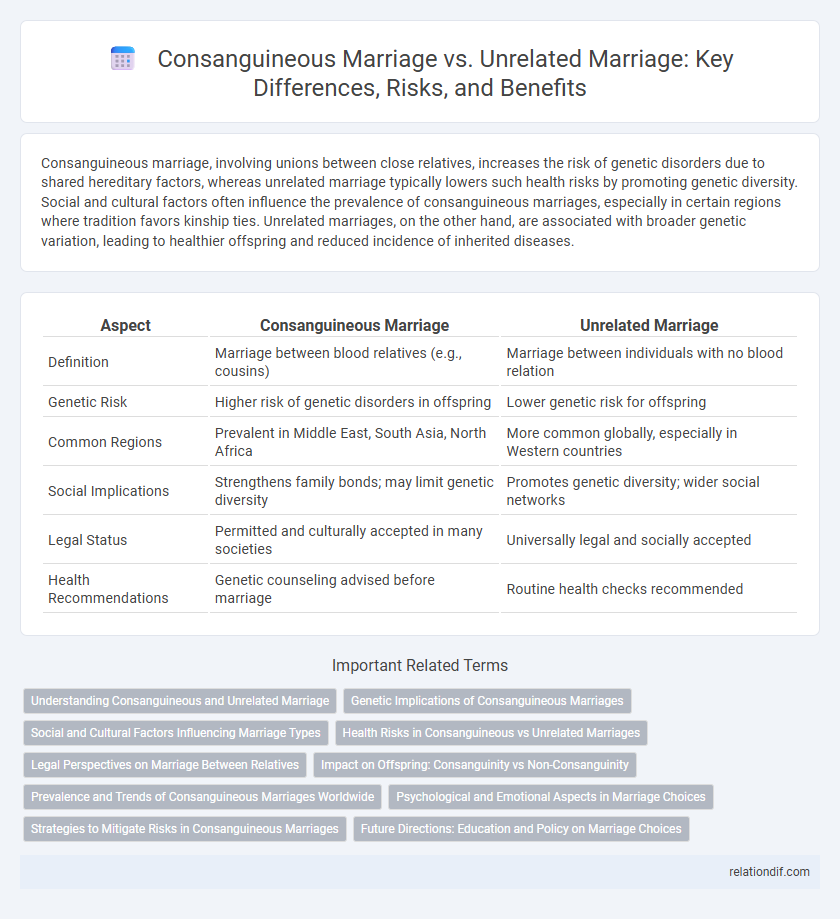Consanguineous marriage, involving unions between close relatives, increases the risk of genetic disorders due to shared hereditary factors, whereas unrelated marriage typically lowers such health risks by promoting genetic diversity. Social and cultural factors often influence the prevalence of consanguineous marriages, especially in certain regions where tradition favors kinship ties. Unrelated marriages, on the other hand, are associated with broader genetic variation, leading to healthier offspring and reduced incidence of inherited diseases.
Table of Comparison
| Aspect | Consanguineous Marriage | Unrelated Marriage |
|---|---|---|
| Definition | Marriage between blood relatives (e.g., cousins) | Marriage between individuals with no blood relation |
| Genetic Risk | Higher risk of genetic disorders in offspring | Lower genetic risk for offspring |
| Common Regions | Prevalent in Middle East, South Asia, North Africa | More common globally, especially in Western countries |
| Social Implications | Strengthens family bonds; may limit genetic diversity | Promotes genetic diversity; wider social networks |
| Legal Status | Permitted and culturally accepted in many societies | Universally legal and socially accepted |
| Health Recommendations | Genetic counseling advised before marriage | Routine health checks recommended |
Understanding Consanguineous and Unrelated Marriage
Consanguineous marriage involves unions between individuals who share a common ancestor, often resulting in increased genetic risks due to inherited recessive traits. Unrelated marriage, in contrast, occurs between partners with no known familial connections, typically lowering the probability of genetic disorders in offspring. Understanding these distinctions is crucial for assessing potential health implications and cultural practices associated with marriage choices.
Genetic Implications of Consanguineous Marriages
Consanguineous marriages, defined as unions between closely related individuals, significantly increase the risk of autosomal recessive genetic disorders due to higher homozygosity rates in offspring. Studies indicate a two- to three-fold rise in congenital anomalies and inherited metabolic diseases in populations with prevalent consanguineous unions compared to unrelated marriages. Genetic counseling and carrier screening are crucial interventions to mitigate hereditary risks associated with consanguineous reproduction.
Social and Cultural Factors Influencing Marriage Types
Consanguineous marriage, prevalent in regions like South Asia and the Middle East, is often influenced by cultural traditions that emphasize family unity, property retention, and social cohesion within kinship groups. Unrelated marriages, more common in Western societies, tend to reflect values of individual choice, romantic love, and social mobility, influenced by urbanization and modernization. Both marriage types are deeply shaped by religion, social norms, economic status, and community expectations that govern marital decisions and family structures.
Health Risks in Consanguineous vs Unrelated Marriages
Consanguineous marriages, typically between close relatives such as first cousins, carry a significantly higher risk of genetic disorders and congenital anomalies due to increased homozygosity of recessive alleles. Studies indicate that offspring from consanguineous unions have a 2-3 fold higher incidence of autosomal recessive diseases compared to those from unrelated marriages. In contrast, unrelated marriages show a lower prevalence of inherited health risks, making genetic diversity a protective factor against inherited disorders.
Legal Perspectives on Marriage Between Relatives
Legal perspectives on consanguineous marriages vary significantly across jurisdictions, with many countries enforcing strict prohibitions or restrictions to prevent unions between close relatives due to potential genetic risks and social concerns. Statutes often define prohibited degrees of kinship, commonly banning marriages between siblings, parents and children, and first cousins in some regions, while allowing more distant relative unions under regulated conditions. Courts and lawmakers balance cultural traditions with public health policies, influencing marriage laws to ensure both legal validity and the welfare of potential offspring in consanguineous unions.
Impact on Offspring: Consanguinity vs Non-Consanguinity
Consanguineous marriage, involving unions between closely related individuals, increases the risk of autosomal recessive genetic disorders in offspring due to higher homozygosity. In contrast, unrelated marriages reduce the probability of inheriting the same deleterious alleles, leading to lower incidences of congenital anomalies and genetic diseases. Studies show that non-consanguineous unions contribute to greater genetic diversity and overall healthier offspring outcomes.
Prevalence and Trends of Consanguineous Marriages Worldwide
Consanguineous marriages, particularly prevalent in regions such as the Middle East, South Asia, and North Africa, account for approximately 20-50% of all unions in these areas, reflecting deep-rooted cultural, social, and economic factors. Global trends indicate a gradual decline in consanguineous marriage rates due to increased urbanization, education, and awareness of genetic risks, while unrelated marriages dominate in Western and many urbanized societies. Statistical data from the World Health Organization and demographic studies highlight a significant regional variation, with consanguinity rates as low as 1-2% in Europe and North America compared to much higher figures in traditional communities.
Psychological and Emotional Aspects in Marriage Choices
Consanguineous marriage, involving partners related by blood, may influence psychological dynamics through familial expectations and shared cultural values, potentially fostering strong emotional support but also increasing risk of intra-family conflict. Unrelated marriage often emphasizes individual choice and emotional compatibility, which can promote personal autonomy and diverse perspectives but may lack the ingrained familial trust found in consanguineous unions. Psychological well-being in both types hinges on communication, mutual respect, and adaptability to the distinct emotional landscapes shaped by family background and social connections.
Strategies to Mitigate Risks in Consanguineous Marriages
Genetic counseling is a crucial strategy to assess and manage the risks associated with consanguineous marriages by identifying potential hereditary disorders. Prenatal screening and advanced genetic testing help detect anomalies early, facilitating informed reproductive decisions. Public health education campaigns also play a vital role in raising awareness about genetic risks and promoting preventive measures within consanguineous couples.
Future Directions: Education and Policy on Marriage Choices
Future directions in marriage choices emphasize enhancing education on genetic risks associated with consanguineous marriage, specifically the increased likelihood of autosomal recessive disorders in offspring. Policy initiatives advocate for culturally sensitive counseling programs and mandatory premarital genetic screening to inform couples about potential health impacts. Research supports integrating community-based awareness campaigns to balance respect for traditions with public health goals, aiming to reduce congenital anomalies linked to consanguinity.
Consanguineous Marriage vs Unrelated Marriage Infographic

 relationdif.com
relationdif.com